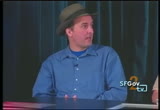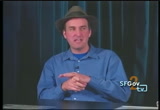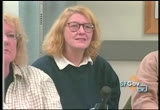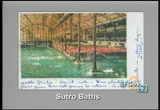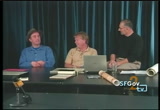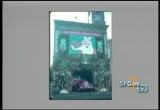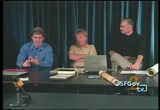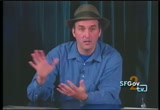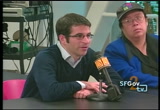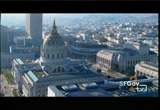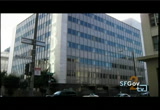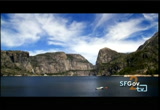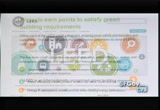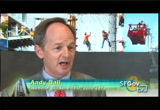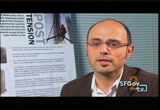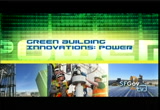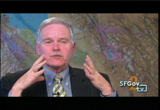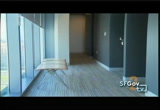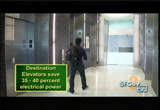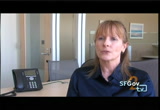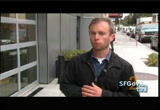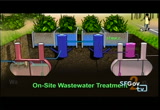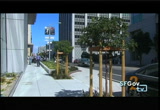tv [untitled] December 27, 2012 6:30pm-7:00pm PST
6:30 pm
he got out with his money. >> i bring it up as a reference that he had the engineering history, which allowed him to figure out how to do it. >> he was good that creating large, engineering marvels. >> this was one. the largest indoor pool. >> it might have been. it became an ice skating rink. i was there when it was an ice skating rink, probably the year before it was burned down. the mummies were there. >> he had that victorian style of stuffing everything he could into this place. he had seashells and jaguars and everything he thought might be interesting or educational to people. people would come over to swim, but they could also see a huge tableau of "the last supper."
6:31 pm
>> right over here is woodward gardens. he started collecting stuff. he invited people over and eventually opened it up to the public. he had a menagerie. >> it was an 1800 thing. >> could any of the people in this room go? >> ice skating. >> ice skating. >> you could see the remains of the pool. i thought the ice rink was made out of one of the largest pools. >> yes. you can see the ell that goes around. they tried to make it a tropical beach theme. they had a bunch of sand. like you could not go to the
6:32 pm
beach 40 feet away. >> it did burn down. it seems like it would have been a wonderful resource for the city to purchase it and rebuild it -- >> you could never afford the money to rebuild it. >> there were efforts to try to keep it. someone tried to sell it to the city in the 1950's. they kept it going with the ice skating rink. it closed and it looked bad. people thought we should buy it and keep it. other people wanted to put condos in there. a serious fire started and the whole place burn down. they still talk about it as a mysterious fire. it could have been an insurance thing. >> hello, gladys. was glad to hear from you and not going to return.
6:33 pm
will write in a few days. >> that is a bath and the house behind. >> you can see the chimney heating that area. >> a pool opened in the 1920's. they talked about how they were going to keep it, but they never did. -- to heat it, but they never did. >> this is a publicity shot. this was the world's largest public pool. they had lifeguards in boats. this was a beautiful building. it is boarded up and full of rats and homeless folks. this is a parking lot now. $8 and you can park there. the beach was a big pleasure place. they would go for sunday picnics
6:34 pm
and stay all day. an amusement park developed to cater to these people. >> i think we have a shot of the fun house. >> she was not in the fun house. she was in a glass thing at the fun house. it was an animatronics robot who went "ha ha ha ha" all day and scared generations of san franciscans out of their wits. it has a month-to-month lease at fisherman's wharf. >> they moved it to this temporary location at fisherman's wharf. they left an unusual little
6:35 pm
treasure of the city. >> ingleside terraces, again, i was trying to show off the residence park. a lot of crazy building. for still has one of the great stairways -- forest hill has one of the greats their ways. -- great stairways. this looked like a ship. they used to decorate fire houses for christmas. >> on the side of this fire house is a wooden tower. the tower was for drying the hoses. after they get water in them, they have to be dried. >> a fire house like this is for
6:36 pm
sale. if you have $1.3 million, which is really cheap enough for a firehouse -- >> one in the inner sunset was just sold. >> was it? i want to buy a streetcar. i cannot pay my rent. >> there were two of these for pumping water out of the ground. murphy gave a lot of money for it. >> what decided the boundaries and the location of golden gate park? >> it was a deal that they basically cut in 1868. the up side lands were up for grabs. it was u.s. government land, san francisco land, and then you had these squatters. these were rich men who decided maybe they could make some money. >> you put up a fence and you
6:37 pm
owned the land. >> it can to a compromise. squatters get some. you have certain military things reserved, government. we will create a public park. everyone donated a certain amount to create golden gate park. they also created smaller parks. there were all part of the deal. >> a lot of people got moved closer to downtown as part of the deal. if you are out in the middle of nowhere land and had a couple of acres, they would trade you a better acres somewhere else. >> how was it decided to put it where it is? >> it was controversial. people thought they could not put a park there because it was all sand dunes. people were pushing for a large city park in other places. it was a political compromise. >> between lincoln and fulton
6:38 pm
and the beach. >> you're saying, why did they decide that exact plot? they brought someone from new york to come up with a park plan. they eventually made it a rectangle. they had the panhandle part. the panhandle was the same with as golden gate park, but there was dealmaking going on between park commissioners and they decided they would buy the land and cut off part of the panhandle. >> the development of lincoln park is interesting. you can see the cemetery. >> on the map, it is a cemetery. >> what happened to that and all of the bodies? >> they decided around the turn of the century the land was too
6:39 pm
valuable to bury people. where uss is now there were four cemeteries. they moved all of the cemetery's out -- cemeteries out. the heir did not want to move one of the places. there are two people -- two places where people are buried in the city. the other ones were moved out. >> the big scandal of lincoln park, someone wanted to build the legion of honor out there. she did and she got it done. they had to prepare the land, the golden gate cemetery, so the people they hired did not get rid of any of the bodies. they got rid of the headstones.
6:40 pm
they built a museum. when the renovated it in the 1990's and started digging ground, nothing but hundreds and hundreds of bodies. >> skeletons. >> skeletons. it was a big scandal. they created a mass grave and moved to the remains. there are pictures. they have thiese skeletons sticking out of the wall. it showed the relative worth. they stopped digging because they would keep finding bodies. >> they are still out there. there are bodies all over the place. they used to bury people in north beach. they would go up there and very bodies. >> there were removed from many of these cemeteries. there is a slogan that is -- anybody know?
6:41 pm
"it is great to be alive." >> beats the alternative. >> i was wondering if gary boulevard had always been a major thoroughfare. >> it used to have streetcars on it. they are thinking of bringing them back. the b line and the a line where there until the mid-1950's. we are taking the street cars away, but bart will come out here and everything will be fine. >> downtown, gary ave. >> when you get past it, it becomes gary boulevard. >> they wanted streets to be large, they should have vegetation and trees, they should be ornamental. gary strieker was the main road from the 1850's. -- gary street was the main road
6:42 pm
from the 18th of the's. >> it was planned as a major thoroughfare. >> it was a toll road originally. we make people pay to get on the road and we make them pay when they get to the clubhouse. it was a toll road. >> i think that does it for today. thank you for coming and sharing your information and great knowledge. we wi >> san francisco is home to some of the most innovative companies of the 21st century. this pioneering and forward looking spirit is alive in san francisco government as well. the new headquarters of the san francisco public utilities commission at a5 25 golden gate avenue is more than just a 13-story building and office ablation.
6:43 pm
instead, city leaders, departments and project managers join forces with local architectural firms ked to build one of the greatest office buildings in america. that's more than a building. that's a living system. ♪ ♪ when san francisco first bought this land in 1999, it was home to a state office building. >> this was an old eight-story brown building the state owned and the workers' comp people were in that building. it was an old dee correctvth it building for decades. when i was a member of the board of supervisors, all of us wondered why we hadn't done anything there and the mayor thought the same. >> if an earthquake happened, the building was uninhabitable. it sat there vacant for quite a while. the city decided to buy the building in 1999 for $2.
6:44 pm
we worked and looked at ways that we can utilize the building for an office building. to build an icon i can building that will house a lot of city departments. >> the san francisco public utilities commission has an important job. we provide clean, pristine public drinking water to 2.6 million people in the san francisco bay area from the hetch hetchy regional water system. with also generate clean renewable energy for city services like public buses, hospitals, schools, and much more. and finally, we collect and treat all the city's wastewater and stormwater making it safe enough to discharge into the san francisco bay and pacific ocean. >> in 2006 the puc was planning a record number of projects. >> the public utilities commission is a very infrastructure-rich organization. we're out there rebuilding the water system. we've budget working on power generation in the country. we've been doing sewer for the city. we're looking at a brand-new rebuild of all watt systems in san francisco and we haven't had a home that's been other than mental.
6:45 pm
>> they staff over 900 people. the puc is in two office locations. >> you know, this is such a great place for a building. if the puc owned that building and we could make that the icon i can sustainable building puc represents, wouldn't be a dramatic idea? >> so, one of the major decisions we made was we wanted to make a statement with this building. we wanted this building to be a lead platinum building which is very few buildings in san francisco that achieved this mark. >> leadership and energy environmental design, it takes a look at the way we think about the places where we live and work. i like to think of it as designed for human and environmental health. lead addresses five categories that enhances environment. indoor air quality, energy, water, materials and resources, and sustainable sites are the
6:46 pm
five categories for the lead. you can go for several gold or platinum certifications. >> the city wanted to be silver lead status. . maybe gold was a stretch. and people said, if we're going to be a sustainable organization that the pucs this has got to be the top of the line. it's got to be a lead platinum building. what does that mean to us? we run water, power, and sewer. so, those are some of the biggest things involved in lead platinum. ♪ ♪ >> by late 2008 the project, as we got the contractor on board and we were able to start pricing it, we're a multi-, multi-, multi-million dollar over budget. >> the story a lot of people don't know after we got select today do this project, the first price we came in with was $180 million. and the city said, you know, this is a great building, but we just don't want to spend that much money.
6:47 pm
so, the project was on the verge of being canceled. >> if you're looking at why this building came to be, in many ways it also included mayor gavin newsome, particularly, who really had an affection for this building. he saw the design. he saw the potential. he wanted to make sure that that building got built. and he said, do what you need to do, but please, if you can make that building work, we need to have that building in civic center. >> i happened to be at a green conference santa clara. he said you shouldn't cancel that project. can you work with us? michael cohen phoned me up the next day. can we cut $40 million out of this project? it was one person more responsible than any others, it's tony irons, was the architect that was responsible for the revitalization of city hall who came to my office and said, we cannot abandon this. we can't walk away from this project. we have an opportunity to really take a lot of our values and principles, particularly raising the bar as we did as a city on our green building
6:48 pm
standards, mandating the most aggressive green building standards for private construction anywhere in the united states. and showcasing them in this new building. >> the city for the sfpuc, it was critical that the building stay as a lead building. the easiest thing to do to cut out millions of dollars, let's just go from lead platinum to lead gold. but that wasn't the objective. this needed to be the best example of energy conservation of any office building in the united states. >> we became involved in the san francisco public utilities headquarter project during the time when the project was at a stand still for a number of reasons, largely due to budget issues. and at the time we were asked to consider an alternative design using concrete rather than the scheme that was potentially planned for previous to that, which was a steel frame structure that used hydraulic dampers to control seismic motion. >> so, i met with my team.
6:49 pm
we worked hard. we came up with a great idea. let's take out the heavy steel structure, let's put in an innovative vertical post tension concrete structure, great idea. we did that. a lot of other things. and we came up with a price of 140 million. so, we achieved that goal. and, so, when we first started looking at the building, it was going to cost a lot of money. because of the way it was being built, we could only get 12 floors. we wanted more space for our employees. we ended up going and saying, okay, if we do a concrete building instead, which was web core's idea, we can get 13 floors, not 12 floors. the concrete doesn't require much space between the floors as a steel building does. and it could be cheaper. yes, more space, less money, great idea. ♪ ♪ >> we know that right now there are things happening in power, with sewer, with water that are not always proven technologies, but they're things that are
6:50 pm
enough proven you should take a bit of a risk and you should show others it can be done. >> we're showing the world, suddenly had wind turbines which they didn't have before. so, our team realizing that time would change, and realizing where the opportunities were today, we said, you know what, we started out as really something to control wind as an asset, when you combine today's technology becomes something entirely different. >> wind turbines in an urban environment is a relatively new concept. there are a few buildings in other major cities where they have installed wind turbines on the roof. and wind turbines in buildings are effective. >> the discussion was do we do that or not? and the answer was, of course. if they're not perfect yet, they're building a building that will last 100 years. in 100 years someone is going to perfect wind efficient turbines.
6:51 pm
if these aren't right, we'll replace them. we have time to do that. >> the building that's two renewable energy generations. wind turbines located on the north facade. two different levels of photo volume takes. >> we have over 600 solar panels and three platforms on the building, and four integrated wind turbines. the wind turbines and the solar panels produce 7% of the building's energy. and we're reducing the use of energy here by 32% in the office building. >> the entire building is controlled by a complex computer system which monitors and adjusts air, heating and lights as well as indoor shades. >> the building is going to be a smart building. it's going to have all integrated features. so, it has a monitor on the roof that knows where the sun is. as it gets warmer or colder, it heats and cools the building. as it gets lighter, shades can
6:52 pm
go up or down to make sure that you're not over using any kind of heat or air conditioning, but as it gets darker the shades can go back up. the lights inside the building self-adjust depending how close they are to the light sources outside, how light it is, how dark it is. so, you're not using energy more than you need. >> we also have occupancy sensors. if nobody is in that room, lights turn off. it's likely to have sustainable features. it's another thing to have an integrated systems sustainability. >> when you have a building that's lead platinum, there are a couple themes important. one is daylight harvesting where you harvest the daylight and have it penetrate the building so that people have views, they see sunlight, which means that partitions and workstations are much lower so that people can see. >> so, human comfort combined with light reduction, the amount of electric light reduction, all with the aim of
6:53 pm
creating, you know, a marvelous workplace that people want to come to, feel comfortable working in, thrive at what they're doing, all kind of integrate together. and the daylighting lighting strategy is a very important part of that equation. >> one of the keys to this building is that we're maximizing the use of natural daylight to light the building. >> here in our south facade we have light shells. they help shade the floor, but as well light bounces off of the light shells into the interior of the floor providing more daylight into the interior of the floor. lighting is both the greatest use of energy consumption in an office building, but it also contributes to the largest amount of heat gain in the building. we're maximizing the use of natural daylighting. we also have light sensors that minimize the use of artificial lighting. >> by having light outside the building skin, what that does
6:54 pm
is we are mitigating it before it hits the glass. we have a high performance, low formal gain graph. the system does not have to work as much to either cool the building or heat the building. >> this building also incorporates or utilizes under floor system for delivery of heating and cooling to the building. this in conjunction with the high efficiency equipment that we've installed in the building reduces the consumption of energy for heating and cooling by 51%. >> we have two destination elevators. destination elevator save 35 to 40% of the electrical energy over traditional elevator. these elevators save energy by using a regenerative drive. when the cars are going up empty or down full of people, they generate electricity that goes back into the building grid. these elevators have energy by grouping people going to the same floor in the same cab. and the way they work is you have a shared elevator call
6:55 pm
button in the lobby. you would indicate which floor you're going to, for instance like 3, and it will direct me to elevator c. so, i'll go to an elevator with people that are going to that same floor. what's also interesting is inside the elevator floor cab there are no selection buttons because i selected my floor in the lobby. this takes some getting used to as we're all accustomed to choosing our floor inside the elevator cabs. ♪ ♪ >> another thing we saut that was a challenge for this building was the permitting process for the delivery machine to use reclaimed water in an office building. and i think that we really broke the ground for future use to be much more commonplace for utilization of reclaimed water in office buildings. this building uses 60% less water than a typical osv building.
6:56 pm
that's achieved by using rainwater for landscaping, treating wastewater on-site for reuse in the building's toilets. >> the machine is an ecological waste treatment system for water resouls. so, the living machine to accelerate what happens naturally in nature is biomimickery that happens in tidal estuaries. it brings in nutrients to the microbes. it's delivered in the air, and does the rest of the process, chewing up those nutrients in the water and producing nitrogen and carbon. we're doing that in a system where we're creating 12 to 16 tides per day. >> the wastewater for our building begins its journey by travel tog our primary tank which is a fairly normal looking manhole. beneath these manholes is a
6:57 pm
10,000 gallon primary tank. there are two chambers. the trash chamber which filters out the trash and plastics and the organic solids settle out just as normal wastewater treatment process is. the water then flows to an equalization tank, a recirculation tank, and then on to tidal flow wetlands cell 1a. all those these cells look to be only 3 or 4 feet deep, they're actually 8 feet deep below this concrete sidewalk. the water repeatedly cycle into the cell from the bottom up. as the water comes up into this cell, it meets the microbes here to treat the wastewater. they flourish off the organics found in the wastewater. after multiple cycles, most of the wastewater treatment has already occurred and the water then flows to the vertical cells located around the corn iron polk street. 2c is located half outside on polk street and half inside in the building lobby.
6:58 pm
after the final polishing, the water flows to the disinfection room of the basement of the building. there the water goes through two disinfection processes. first ultraviolet light, and second a dosing of chlorine. the treated water is stored in a 5,000 gallon reclaimed water tank where it is pumped throughout the building for toilet flushing purposes. the treatment cycle is complete and the water is reused again and again. this new building features a rainwater harvesting system. rainwater is captured from the building's roof and the children's play area along the side of the building and sent down to our disinfection room where there is a 25,000 gallon sis tern. the rainwater receives minor treatment and is used to irrigate the building's trees and landscaping. >> when we're resues using water we have on-site, we're not purchasing new water and we're also not putting sewage down into the sewer system which is costs money. this is a demonstration project of 5,000 gallons a day. it is the beginning of understanding and feeling comfortable with this
6:59 pm
technology that can be scaled up into eco districts and community scale systems, campus-type systems where in those situations when the water is reused and the numbers are much higher, 50,000, 100,000, 200,000 gallons a day, imagine the savings on that that you're getting. you're not purchasing freshwater and you're not using the sewer and being charged appropriately. this wastewater processing and reuse technology is cutting edge. and although it's been successfully implemented in other cities, it will be one of the first such installations in an urban office building. >> here is a city agency that treats wastewater, but they send no wastewater to the treatment facility. that says a lot. >> it's got a 12 gallon per day occupancy using 5,000 gallons per day with a building officing 1,000 people. that turns out to save over 2.7 million gallons a year.
81 Views
IN COLLECTIONS
SFGTV2: San Francisco Government Television Television Archive
Television Archive  Television Archive News Search Service
Television Archive News Search Service 
Uploaded by TV Archive on

 Live Music Archive
Live Music Archive Librivox Free Audio
Librivox Free Audio Metropolitan Museum
Metropolitan Museum Cleveland Museum of Art
Cleveland Museum of Art Internet Arcade
Internet Arcade Console Living Room
Console Living Room Books to Borrow
Books to Borrow Open Library
Open Library TV News
TV News Understanding 9/11
Understanding 9/11